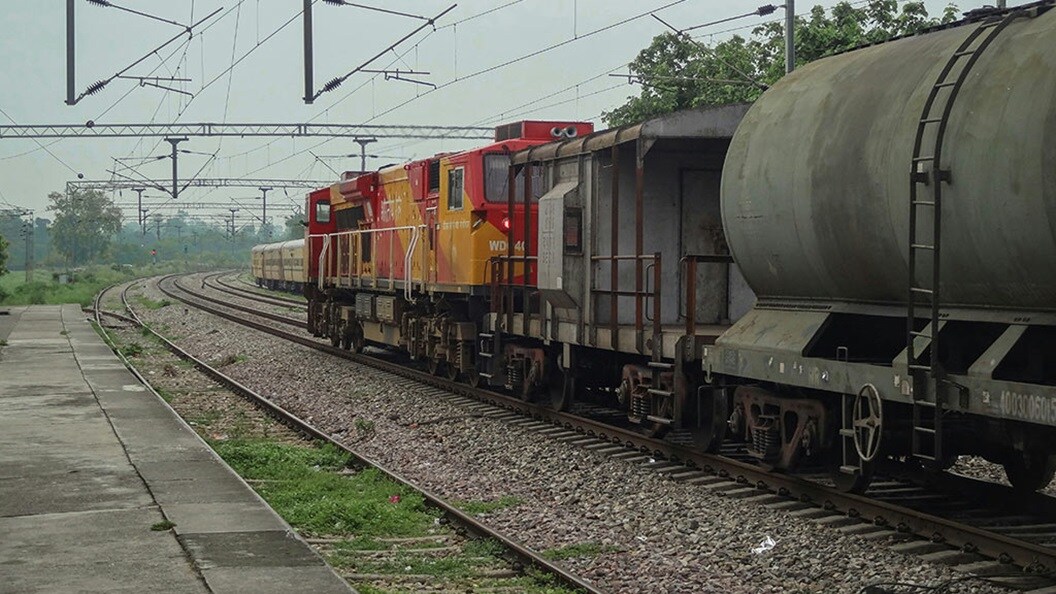Rail freight in India plays a pivotal role in the nation's transportation infrastructure, moving 27% of all goods in the country across its 68,000-km network. With one of the largest railway networks in the world, India's freight trains traverse diverse terrains, connecting industrial hubs, agricultural regions, and ports.
Operated under a single administration – the Indian Railways – the freight system handles an array of commodities, including coal, minerals, agricultural produce, petroleum products, and manufactured goods, and moves approximately 1.4 billion tonnes of freight traffic.
Investing in the future of logistics in India
In recent years, the Indian government has been focused on making the country a global logistics powerhouse and has invested in numerous schemes and projects towards this goal. In 2022, the National Logistics Policy was launched to provide a tech-enabled, integrated, cost-effective, and future-proof logistics ecosystem. As part of this policy, the 900-acre Integrated Multi-Modal Logistics Hub is being developed in the state of Haryana, to centralise freight consolidation and reduce logistics costs.
Budgets have been set aside for the construction of expressways and dedicated freight corridors, and private investment is being encouraged for the development of logistics hubs and improved warehousing facilities to reduce freight costs and improve lead times.
Additionally, dedicated rail freight corridors have been commissioned to reduce road congestion. These developments can be a game-changer for the country’s logistics industry, which has till now been riddled with problems of storage, inconsistent visibility and tracking, freight clearance issues, complex documentation processes, and lack of expertise.
What is slowing down rail freight development in India?
Despite its extensive network, Indian rail has been plagued by numerous challenges that impede its efficiency and growth potential, such as:
- Infrastructure constraints: While the Indian Railways has been developing its freight network, not enough is being done to upgrade ageing infrastructure and reduce capacity limitations. Key freight corridors face bottlenecks that constrain the smooth movement of goods and passenger trains are given priority of passage, adding to delays.
- Government cutbacks: The Indian government’s goal to double its freight volumes to 3 billion tonnes by 2030 has faced hurdles due to construction delays, reduced volumes of goods like food grains, and budget cuts under the existing schemes.
- Cargo handling: The Indian rail network is still highly dependent on human intervention, which often leads to congestion, delays, and inefficiencies in cargo handling and transportation at major freight terminals and junctions. Addressing congestion requires better coordination among different stakeholders and investment in infrastructure expansion projects.
- Inland connectivity: While the country’s major cities are well-connected by rail, the same cannot be said for connectivity to industrial centres and ports. Developing robust connectivity solutions, such as dedicated freight corridors and logistics parks, is crucial to improve accessibility and efficiency and ensure the seamless flow of goods.
- Competition from road transport: Unlike road transport, which can access more destinations, provide flexible transit times, and offer tracking options, rail freight, especially for short to medium-distance haulage, is restricted to the rail network and has not been upgraded to provide reliable real-time updates on the cargo.
- Safety and security: Theft and damage in transit are a common problem when transporting goods via rail. Ensuring the safety and security of freight shipments is paramount to maintaining trust among customers. Preventing accidents, reducing theft, and enhancing surveillance along rail routes are critical areas that require continuous attention and investment.
- Technology integration: When compared to its global counterparts, Indian rail freight has been slow to adopt technology. Whether hindered by bureaucratic hurdles or inefficient adoption of available technologies, rail freight in the country is still heavily dependent on human intervention.
Way forward for Indian rail freight
Despite various setbacks, Indian Rail is set on expanding their freight network with the construction of dedicated freight corridors, digitalisation of schedules and documentation, and set-up of freight hubs. “Most of the global railway systems originated as government controlled. If DB (Deutsche Bahn AG), and CRRC (Chinese Railways) can reinvent themselves, then why can’t Indian Railways?” asks Lalit Trivedi, Retired General Manager, Indian Railways. “Even in India, till a few decades back, airlines, telecom, banking, power utilities, etc., were government controlled. Today there are multiple competing players resulting in superior services to customers,” he adds.
For rail freight to develop and offer competitive logistics solutions, there needs to be a collaborative effort between the railway administration and private logistics companies to address various aspects of the system. These include:
- Intermodal connectivity: The railway administration needs to provide total transport solutions from door to door by taking care of requirements of warehousing and first- and last-mile connectivity. “This might require Indian Railways to enter strategic tie-ups with entities having core strength in warehousing/trucking, etc. Private sidings need to be promoted to eliminate issues related to first and last-mile connectivity,” Trivedi suggests.
- Infrastructure development: To reduce congestion and facilitate faster movement of freight requires expansion and modernization of rail networks. Dedicated freight corridors will enable faster and more efficient freight transportation. Upgrading and modernizing rail infrastructure is essential to enhance capacity and reduce transit times.
- Technology integration: For rail freight to be considered a viable option, innovation needs to be at the heart of logistical development. GPS tracking, data sharing, automation and advanced signalling systems, and scheduling software can improve cargo control and reduce mid-journey delays and track congestion. Introducing automation and robotics for loading and unloading operations can help reduce time and labour costs.
- Equipment upgrades: Numerous delays, accidents, and cargo damage incidents have been attributed to ageing rail equipment. By investing in newer and more efficient freight wagons and locomotives, the administration can improve capacity and energy efficiency. Specialized freight containers for different types of cargo can also ensure safety and ease of handling. “Capacity of critical sections/routes should be improved by providing auto signalling and additional loops, besides multi-tracking. There is a need to increase the speed of trains by improving brakes and power input per ton of the train load. Higher axle-load trains which permit higher payload must be run on dedicated routes suitably upgraded for the purpose,” says Trivedi.
- Operational efficiency: Streamlining administrative processes and reducing paperwork can increase efficiency while the implementation of better scheduling and coordination of freight trains will help minimize delays and optimize capacity utilization.
- Customer relations and transparency: Real-time tracking updates and improved communication channels can support customer relations. Additionally, transparent pricing and freight rates will draw in more business and make rail transport more competitive compared to road transport. Trivedi suggests that regular web updates featuring real traffic constraints, availability of rakes, and other information in real time along with stout grievance redressal mechanisms can help increase transparency and draw in more customers. “Governments should reward companies and business entities that opt for rail transportation, by awarding them with carbon credits,” he adds
- Policy reforms: Rail freight in India can benefit from increased efficiency and investment by encouraging private sector participation in rail freight operations through public-private partnerships (PPP). Simplifying regulatory procedures also ensures a conducive business environment for freight operators. “Setting up private rail cargo terminals (Private sidings) needs to be further incentivised so that there are no detentions, either at the time of entry or departure from a terminal,” Trivedi says, adding, “One of the underlying reasons for coal being the major commodity moved by Indian Railway is that it is transported end to end on rail as there is a line from the mine to the thermal power station to which it is supplied.”
- Skill development: Investing in training programs for railway staff and freight operators will enhance skills and knowledge, leading to better service and safety standards.
Overall, a combination of infrastructure development, technological advancements, operational improvements, policy reforms, and a focus on reducing GHG emissions can significantly enhance the efficiency and competitiveness of Indian rail freight. “Once this is done, the demand will automatically shoot up as many corporates and other stakeholders prefer rail as it has lower GHG emissions compared to other options of transport and can be a more economical means too if all the loose ends of the complete logistics chain and accompanying ecosystem are tied up,” Trivedi adds.
Embracing the potential of rail freight with investment by the government and industry stakeholders will not only enhance the efficiency of logistics operations in India but also contribute to a resilient economy.
Sign up to The Logistics Pulse newsletter
You did it, welcome onboard!
We're sorry, but there was a problem sending your contact request.
Please review the form fields and ensure all required information is provided correctly. If the issue persists, please contact our support team for further assistance.
Sign up to The Logistics Pulse newsletter
Receive our insights directly in your mailbox by signing up through this form and enter a world of truly integrated logistics. Get inspired by our selection of articles that help you navigate supply chains, understand industry trends, and shape your logistics strategy. You can unsubscribe anytime.
I agree to receive logistics related news and marketing updates by email, phone, messaging services (e.g. WhatsApp) and other digital platforms, including but not limited to social media (e.g., LinkedIn) from A. P. Moller-Maersk and its affiliated companies (see latest company overview). I understand that I can opt out of such Maersk communications at any time by clicking the unsubscribe link. To see how we use your personal data, please read our Privacy Notification.
By completing this form, you confirm that you agree to the use of your personal data by Maersk as described in our Privacy Notification.













